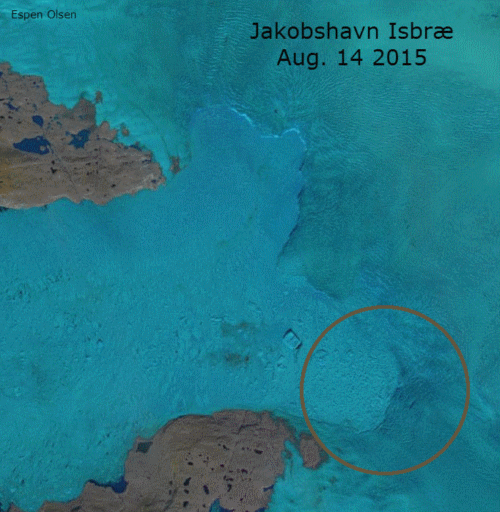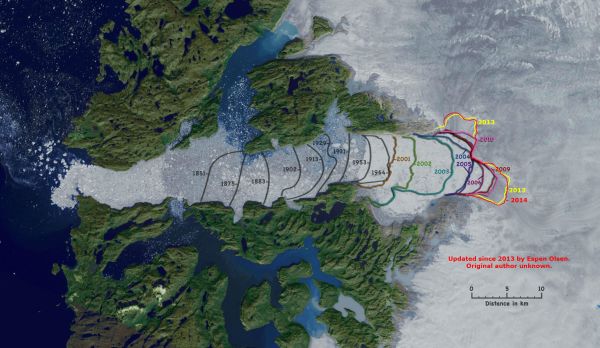Human-Baked Baffin Bay Takes Biggest Bite Yet out of The Greenland Ice Sheet
187
August, 2015
You
wouldn’t generally think of ocean temperatures in the range of 40
to 50 degrees Fahrenheit (5 to 10 degrees Celsius) as hot. But to the
great sea-fronting glaciers of Greenland it may as well be boiling.
Greenland
Ice Sheet in Hot Water
All
it takes is 32 degree F (0 C) water to begin melting the ice. And for
each 1 degree increase above that margin, melt rates will
dramatically ramp higher. Though a typical summer will push ice to
melt at the Greenland seafront ice edge, this year, especially near
Baffin Bay, the melt pressure has been extraordinary.
Ever
since late June, 40-50 degree F sea surface temperatures have
dominated the ice edge zone. For most regions that’s temperatures
in the range of 4-11 degrees Fahrenheit (2-6 C) above average. The
kind of heat that really risks a rapid melt along the ice margin.
A
latent heat that sits at the surface, gnawing away at the ice,
waiting for a fresh water flood. And when the fresh water does come,
that hotter, saltier, heavier water is forced downward beneath the
lighter fresh water outflow. At this point, the hotter waters are
locked below the surface where they go to work eating away at the
glacier base. Notably, the only region within Baffin Bay where we
currently see cooler surface water is in the major glacier melt zone
near Jakobshavn. It’s an indication that ice melt from a major
glacier outflow there is cooling the surface waters even as it pulls
the surface heat downward and toward the glacial base.
This
glacial melt heat conveyor is the kind of process we are seeing more
and more frequently near the great ice sheets as fossil fuel industry
has continued its harmful emissions. And, it’s a process that, this
week took a huge chunk out of one of the world’s fastest moving ice
masses.
Huge
Chunk of Jakobshavn Breaks Off
According
to reports from The Arctic Ice Blog,
the Jakobshavn glacier sent its biggest chunk of ice on record
floating off into Baffin on August 16 of 2015. For a glacier that
drains 6.5 percent of the Greenland Ice Sheet and that has been known
to release icebergs the size of Lower Manhattan, that’s really
saying something.
You
can see this amazing and rather chilling calving event in action in
the August 14 to August 16 satellite imagery comparison developed
by Espen
Olsen below:
(Jakobshavn
experiences what is likely it’s largest calving event yet on
Sunday, August 16, 2015. Image source: Espen
Olson.)
Here
we see the ice-choked Baffin Bay waters rapidly surging inland and
taking up more of the Jakobshavn’s traditional outflow channel.
What we do not see in this image, but what clearly happened, was that
an ice mass hundreds of meters tall and covering
an area of about 12.5 square kilometers was
shattered into flinders as warming ocean waters invaded the Greenland
Ice Sheet. Waters that will deliver still more heat to the ice.
Waters that seek for the very heart of Greenland — a below sea
level basin topped with 2-3 kilometer tall mountains of ice.
Back
in the 19th Century, the Jakobshavn Fjord was half full of grounded
Greenland ice. A long tongue of the glacier extended on outward
through the channel. As of 2015, the Fjord is now completely full of
water and ocean-bound ice bergs. The ocean itself has begun to invade
the much larger ice masses beyond the Fjord. The broader inland mass
of the Jakobshavn Glacier which is now directly in contact with the
rising seas (indicated as Jakobshavn Isbrae on the maps above and
below).
(Warming
waters from Baffin Bay have driven through the ice in the Jakobshavn
Fjord and are now boring into the thicker ice masses of Jakobshavn
Ibrae. An impact that has serious implications for global sea level
rise. Image source: The
Arctic Sea Ice Blog and Espen
Olsen.)
The
inland-retreating Isbrae itself is a vast field of giant ice sheets.
Massive tilting escarpments of luminous ice that, in the current age
of fossil fuel forced warming, often cup great 1-3 kilometer long
melt ponds in their wildly varied topography. It’s a single region
that, in total, may hold about 1.5 feet of global sea level rise
locked away in a rapidly melting ice pack. And Jakobshavn is just one
of many regions (together containing about 15-20 feet worth of sea
level rise) that are currently undergoing rapid melt due to the
invasions of warming ocean waters.
Links:






No comments:
Post a Comment
Note: only a member of this blog may post a comment.